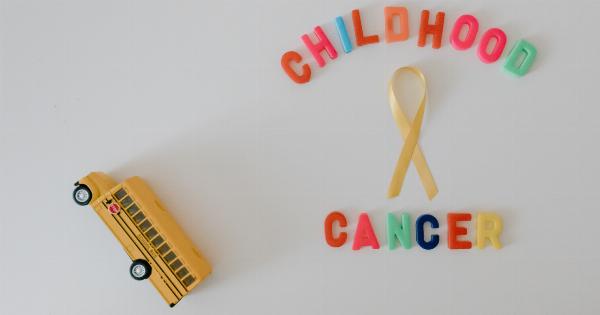Childhood cancer is a rare but devastating diagnosis that affects approximately 300,000 children worldwide each year. Cancer is caused by the uncontrolled growth and spread of abnormal cells, which can damage vital organs and tissues.
Early diagnosis is crucial in the fight against childhood cancer as it can significantly improve the chances of survival and reduce the risk of long-term complications.
Understanding Childhood Cancer
Childhood cancers are different from adult cancers in many ways, as they occur in developing organs and tissues. The types of cancer that affect children are often different from those that affect adults, and they require unique treatment approaches.
Some of the common types of childhood cancers include:.
- Leukemia
- Lymphoma
- Brain tumors
- Neuroblastoma
- Wilms tumor
- Rhabdomyosarcoma
- Bone cancer
The Importance of Early Diagnosis
Early diagnosis of childhood cancer is essential because it can lead to a better chance of survival. Childhood cancers tend to grow and spread rapidly, and if left undetected, they can cause severe damage to vital organs and tissues.
Additionally, early diagnosis can help in choosing the best treatment options that are most effective and have the least amount of side effects.
Some of the signs and symptoms that may indicate childhood cancer include:.
- Unexplained weight loss
- Fatigue and weakness
- Persistent pain in bones, joints, or muscles
- Persistent fever
- Frequent infections
- Headaches and seizures
- Unusual lumps or swelling
- Changes in skin color or texture
- Unexplained bruising or bleeding
If any of these signs or symptoms persist for more than a few weeks, it is important to seek medical attention promptly. A healthcare provider can perform a physical examination and order imaging or laboratory tests to determine if cancer is present.
The Role of Diagnostic Tests
Diagnostic tests play a significant role in the early detection and diagnosis of childhood cancer. These tests can help identify abnormalities or changes in the body that may indicate cancer.
Some of the common diagnostic tests that are used to detect childhood cancer include:.
- Blood tests – to check for abnormal blood cell counts and other indicators of cancer
- Imaging tests – such as X-rays, CT scans, MRIs, or ultrasounds, to look for abnormalities in organs or tissues
- Bone marrow aspiration and biopsy – to check for cancer cells in the bone marrow
- Tumor biopsy – to remove a sample of the tumor tissue for examination under a microscope
The results of these tests can help healthcare providers develop a treatment plan that is tailored to the child’s specific needs. Diagnostic tests can also be used to monitor the effectiveness of treatment and detect any recurrence of cancer.
Treatment Options for Childhood Cancer
The treatment options for childhood cancer depend on the type and stage of cancer, as well as the child’s age and overall health. Some of the common treatment options for childhood cancer include:.
- Surgery – to remove the tumor and surrounding tissue if possible
- Chemotherapy – to kill cancer cells using powerful drugs
- Radiation therapy – to destroy cancer cells using high-energy radiation
- Stem cell transplant – to replace damaged bone marrow with new stem cells
- Targeted therapy – to attack specific proteins that are involved in cancer growth and spread
Combined or sequential treatment approaches may also be used to improve the chances of a successful outcome. The goal of treatment is to cure the cancer or reduce its symptoms and improve quality of life.
The Importance of Follow-Up Care
Childhood cancer survivors require lifelong monitoring and follow-up care to detect any long-term complications that may arise as a result of cancer treatment. Some of the potential risks of childhood cancer treatment include:.
- Heart, lung, or liver problems
- Fertility problems
- Hearing or vision loss
- Learning and cognitive difficulties
- Secondary cancers
Regular check-ups, imaging, and laboratory tests can help detect these complications and provide appropriate management strategies.
Conclusion
Childhood cancer is a rare but devastating diagnosis that can affect any child. Early diagnosis is crucial in the fight against childhood cancer, and it can significantly improve the chances of survival and reduce the risk of long-term complications.
If you notice any signs or symptoms that may indicate childhood cancer, seek medical attention promptly. Diagnostic tests and appropriate treatment options can help fight childhood cancer and improve the quality of life for survivors.






























